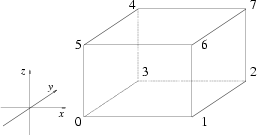
 |
Although they are represented in a canonical form by only two vertices, namely the lexicographically smallest and largest vertex with respect to Cartesian xyz coordinates, we provide functions for ``accessing'' the other vertices as well.
Iso-oriented cuboids and bounding boxes are quite similar. The difference however is that bounding boxes have always double coordinates, whereas the coordinate type of an iso-oriented cuboid is chosen by the user.
|
| |||
|
introduces an iso-oriented cuboid c with diagonal
opposite vertices p and q. Note that the object is
brought in the canonical form.
| |||
|
| |||
introduces an iso-oriented cuboid c with diagonal
opposite vertices p and q. The int argument value
is only used to distinguish the two overloaded functions.
| |||
| |||
|
introduces an iso-oriented cuboid c whose
minimal x coordinate is the one of left, the
maximal x coordinate is the one of right, the
minimal y coordinate is the one of bottom, the
maximal y coordinate is the one of top, the
minimal z coordinate is the one of far, the
maximal z coordinate is the one of close.
| |||
| |||
introduces an iso-oriented cuboid c with diagonal
opposite vertices
(min_hx/hw, min_hy/hw, min_hz/hw) and
(max_hx/hw, max_hy/hw, max_hz/hw).
| |||
|
|
| Test for equality: two iso-oriented cuboid are equal, iff their lower left and their upper right vertices are equal. |
|
|
| Test for inequality. |
|
|
| returns the i'th vertex modulo 8 of c. starting with the lower left vertex. |
|
|
| returns vertex(i), as indicated in the figure below: |

|
|
| returns the smallest vertex of c (= vertex(0)). | ||
|
|
| returns the largest vertex of c (= vertex(7)). | ||
|
|
| returns smallest Cartesian x-coordinate in c. | ||
|
|
| returns smallest Cartesian y-coordinate in c. | ||
|
|
| returns smallest Cartesian z-coordinate in c. | ||
|
|
| returns largest Cartesian x-coordinate in c. | ||
|
|
| returns largest Cartesian y-coordinate in c. | ||
|
|
| returns largest Cartesian z-coordinate in c. | ||
|
|
|
returns i-th
Cartesian
coordinate of
the smallest vertex of c.
| ||
|
|
|
returns i-th
Cartesian
coordinate of
the largest vertex of c.
|
|
|
| c is degenerate, if all vertices are coplanar. |
|
|
| |
| returns either ON_UNBOUNDED_SIDE, ON_BOUNDED_SIDE, or the constant ON_BOUNDARY, depending on where point p is. | ||
|
|
| |
|
|
| |
|
|
| |
|
|
| returns the volume of c. | ||
|
|
| returns a bounding box containing c. | ||
|
|
| |||
returns the iso-oriented cuboid obtained by applying t on
the smallest and the largest of c.
| ||||